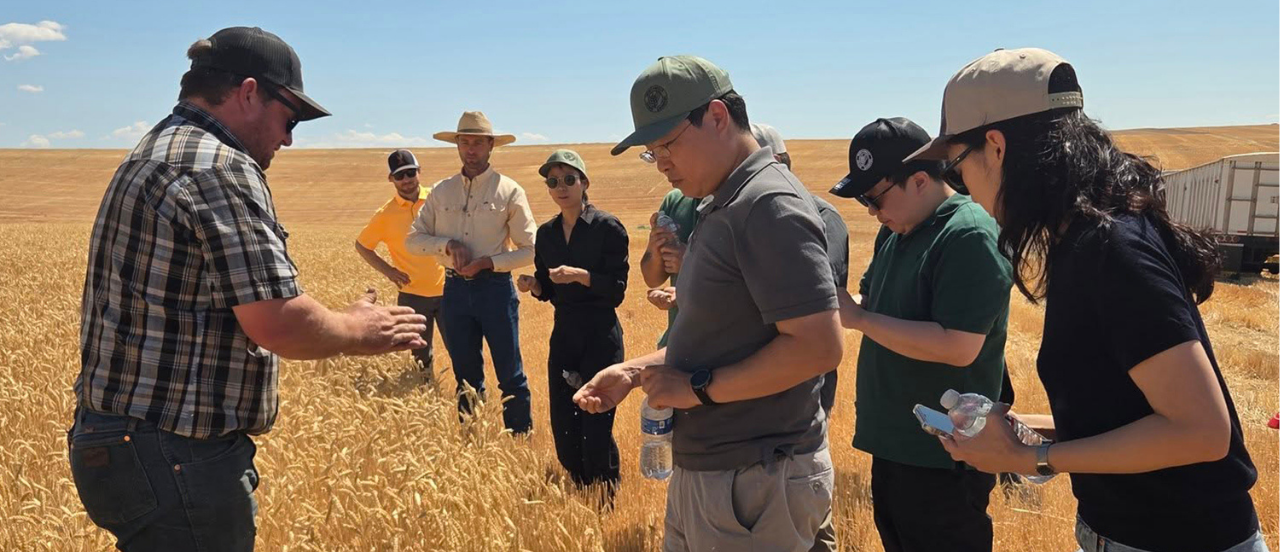As they typically do, the South Korean wheat buyers who explored Washington, Oregon and Montana in late July carried in the back of their minds a lengthy list – a long and growing lineup, actually – of food products back home that depend on high-quality wheat grown in the United States. The trade team hosted by U.S. Wheat Associates (USW) included purchasing and quality managers from six major South Korean milling companies that collectively represent approximately 65% of the Korean flour market.
“For most participants, this was their first direct exposure to the U.S. wheat supply chain, making the experience especially meaningful,” said Channy Bae, USW country director in Seoul, who led the team.
A Firsthand Look at U.S. Grain Inspection and Transportation in Oregon
The 10-day tour began at USW’s West Coast office in Portland, where participants received an overview of U.S. wheat export operations. Stops at the Wheat Marketing Center, the Kalama Export Terminal and the USDA’s Federal Grain Inspection Service (FGIS) allowed the South Korean buyers a chance to observe the export process and quality control systems firsthand. Meetings with traders provided insights into current market trends by wheat class.
The efficiency of the total transportation system was on display: from farm production to loading to a barge on the Columbia River. Guided by the Oregon Wheat Commission, the team traveled east along the Columbia River, learning about the logistical importance of the Columbia-Snake River system, and toured the Northwest Grain Growers’ river terminal facility in The Dalles.
Representing the other end of the supply chain, the team stopped by the harvest fields of Oregon farmer Thad Eakin.
“We had a chance to showcase the multi-generational investments to farm stewardship with a tour at Eakin Ranches in Sherman County,” Oregon Wheat CEO Amanda Hoey said. “The team had a chance to get into the field and cut some wheat with Thad Eakin and his family. We were joined by representatives from Oregon State University to discuss research investments into new varieties with the quality characteristics that have helped develop a preference for soft white wheat grown in our region.”
Exploring Wheat Research, Farms and More in Washington and Montana
In Spokane, Washington, the team received a briefing from the Washington Grain Commission (WGC) on the state’s wheat industry. It then visited the USDA’s Agricultural Research Service (ARS) Western Wheat Quality Lab and the greenhouse at Washington State University in Pullman to learn about ongoing breeding research. The group also toured a barge terminal along the Snake River and visited R&K Farms, where they engaged with multi-generational wheat farmers and gained a deeper understanding of their lives and farming practices.
“Along with the quality of our wheat, the supply chain is always and important aspect of buying decisions in the Korean market, so we were pleased to share how we produce high-quality wheat and how that wheat makes its way from the farm field to the export facility,” WGC CEO Casey Chumrau said. “At the same time, wheat farmers across Washington enjoy meeting customers who take the time to travel from international markets to see the wheat crop and learn about our production processes.”
The final leg of the tour took the team to Bozeman, Montana, where they met with the Montana Wheat and Barley Committee (MWBC) and visited Montana State University (MSU) to learn about the state’s agricultural landscape and breeding programs. They also toured two wheat farms, gaining valuable insights into Montana’s cultivation practices.
“We designed this experience around the significance of land grant research, the beacon of U.S. quality improvement,” said Lori Wickett, MBWC research and communications director. “They spent their time at MSU’s Plant Sciences and Plant Pathology department hearing from winter and spring wheat breeders, entomologists, and MSU Foundation Seed. They toured MSU’s Cereal Quality Lab, greenhouses and the Post Farm where field trials are well underway for new varieties. We visited two farms in Three Forks, where Lieutenant Governor Kristen Juras joined.”
Maintaining Market Share in South Korea
In all, South Korea imports approximately 4.4 million metric tons (MMT) (162 million bushels) of wheat annually. Since 2015, South Korea’s average annual imports of U.S. wheat have been 1.4 MMT (51.4 million bushels). In the 2024/2025 marketing year, U.S. wheat imports surged to 2.34 MMT (nearly 86 million bushels), a substantial increase over the year prior and the 10-year average.
“Last year, U.S. wheat held the largest share in the South Korean milling wheat market at 47.8%, followed by Australian wheat at 43.6% and Canadian wheat at 8.6%,” Bae said. “Much of the credit for that goes to U.S. wheat farmers, who continue to produce a crop that millers, bakers and food manufacturers desire because it helps increase the quality of end-products.”
